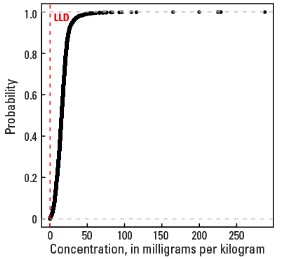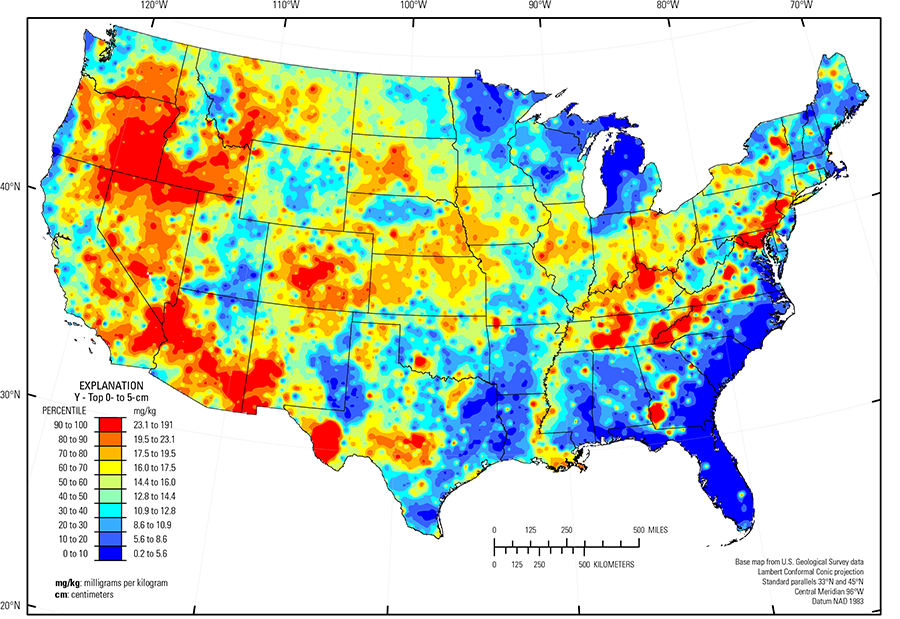
The purpose of these interpretive discussions is to provide a perspective on regional- and national-scale variations in element and mineral distributions in soils and their likely causes. The significant spatial variations shown by most elements and minerals can commonly be attributed to geologic sources in underlying parent materials, but other spatial variations seem clearly related to additional factors such as climate, the age of soils, transported source material, and anthropogenic influences. We attempt to distinguish the influence of these various factors on a regional and national scale. Numerous more local features might similarly be related to these same factors, but these features also have some probability of being an artifact of a random sampling of variable compositions, so that there is some probability of samples with similar compositions occurring in clusters of two or more adjacent sites by chance. Distinguishing such random occurrences from true variability is beyond the scope of the data from which these maps are constructed. Some caution, therefore, is advisable in interpreting the significance of these more local features unless some unique sources or processes can clearly be related to them.
Yttrium (Y) is a metallic element. The metal is not widely used, but several of its compounds are. Yttrium oxide (Y2O3) can be combined with europium (Eu) to produce the red phosphor used in old–style color television tubes. Garnets made from Y and iron (Fe) are used as microwave filters in microwave communication equipment. Yttrium has no known biological role and has relatively low toxicity.
Yttrium shares physical and chemical properties with the rare earth elements (REEs). The distribution of Y in soils is very similar to the distribution of the two REEs determined in this study, lanthanum (La) and cerium (Ce). The abundance of Y in the Earth's upper continental crust is estimated to be approximately 21 milligrams per kilogram (mg/kg) (Rudnick and Gao, 2003). Yttrium may occur in feldspar, pyroxene, and clay minerals. It tends to occur in higher concentrations in accessory minerals, including phosphate–rich REE–bearing minerals, principally xenotime (YPO4), apatite, monazite, allanite (REE–enriched epidote), and sphene. These accessory minerals typically occur in many rock types, with somewhat higher concentrations in felsic igneous rocks (such as granite, rhyolite, and pegmatite), alkalic igneous rocks, and phosphate–rich sedimentary rocks, as well as metamorphic equivalents of all of these rock types. Granite has Y concentrations of approximately 35 mg/kg. Shale has an average Y concentration of approximately 30 mg/kg, with Y in clays or accessory minerals. Of the other common rock types, mafic rocks, such as basalt and gabbro, contain about 20 mg/kg Y, sandstone about 15 mg/kg, and limestone about 4 mg/kg. Some Y–bearing accessory minerals are resistant to weathering, and can be present in unconsolidated materials, such as alluvial, eolian, and glacial deposits. Some REE–bearing (and thus Y–bearing) minerals, including monazite, xenotime, allanite, and zircon, are common detrital heavy minerals that, when released from their parent rock by weathering, can accumulate by density sorting in fluvial, lacustrine, or oceanic coastal shoreline settings.
Statistics and information on the worldwide supply of, demand for, and flow of Y (together with the rare earth elements) are available through the U.S. Geological Survey (USGS) National Minerals Information Center (NMIC) website.
In our data, the median concentration of Y is 15.6 mg/kg in the soil C horizon, 14.6 mg/kg in the soil A horizon, and 14.4 mg/kg in the top 0- to 5-cm layer (see the summary statistics [open in new window]). All soils have Y concentrations above the 0.1-mg/kg lower limit of determination (LLD). Yttrium map patterns are generally consistent among the three sample types.
Relatively high Y concentrations occur in soils developed on a range of volcanic rock types, including felsic rocks (granite and rhyolite), intermediate rocks (alkali basalt, andesite, or syenite), or mafic rocks (such as basalt). Examples of such areas include:
- Parts of the Pacific Northwest (andesite and basalt);
- Parts of the Central Rocky Mountains and Southern Rocky Mountains (USDA, 2006), Colorado, Wyoming, Montana, and Idaho (a variety of rock types, including granite);
- Parts of the Owyhee High Plateau (USDA, 2006), Nevada, Idaho, and Oregon (granite and felsic volcanics);
- Southern Nevada Basin and Range (USDA, 2006), Nevada and California (felsic volcanic rocks and related alluvium);
- Mojave Desert and Lower Colorado Desert (USDA, 2006), California and Nevada (granitic rocks and syenite);
- Trans–Pecos volcanics (Schruben and others, 1997), Texas (rhyolite and alkalic volcanic rocks and related alluvium); and
- Llano Basin, Texas (Precambrian granitic rocks).
Elevated soil Y concentrations in the Kentucky Bluegrass area (USDA, 2006) and the Nashville Basin (USDA, 2006) in Tennessee occur where soils developed on phosphatic, apatite–bearing limestone. Scattered elevated soil Y concentrations through the Southern Blue Ridge (USDA, 2006) and Piedmont (Fenneman and Johnson, 1946) are attributed to occurrences of Y–bearing accessory minerals in metamorphic and granitic rocks. Soils below the 'fall line', the physiographic boundary between older crystalline rocks of the Piedmont and fluvial and marine sediments of the Gulf and Atlantic Coastal Plain (Fenneman and Johnson, 1946), have high concentrations of Y (as well as Ce and La). These soils (for example, several sites in Georgia) developed on sands that likely contain detrital monazite or zircon.
In general, soils developed on recent glacial deposits have moderate to low Y concentrations. In many areas of the Upper Midwest, the southern glacial limit (Soller and others, 2012) marks a change in soil Y concentrations. Soil Y concentrations in the vast loess sheets south of the southern glacial limit are higher than Y concentrations in soils developed in carbonate till north of the ice extent and are likely related to the presence of wind–deposited silt–sized feldspar or a small, but persistent, quantity of accessory minerals, such as zircon.
Other large areas of the conterminous United States with low concentrations of Y in soils typically lack many of the minerals that contain REE. These areas (and their dominant soil parent materials) include:
- Colorado Plateau (USDA, 2006) (quartz–rich sandstone and eolian deposits);
- Nebraska Sand Hills (USDA, 2006) (quartz– and plagioclase–rich unconsolidated sand dunes and sand sheets);
- Southern High Plains (USDA, 2006) in eastern New Mexico and western Texas (quartz–rich eolian sands and alluvial sediments); and
- Gulf and Atlantic Coastal Plain (Fenneman and Johnson, 1946) (quartz–rich sedimentary rocks and unconsolidated sediments)
The Gulf and Atlantic Coastal Plain (Fenneman and Johnson, 1946) is bisected by the Southern Mississippi River Alluvium and the Southern Mississippi Valley Loess (USDA, 2006). Alluvial sediments were deposited in the Mississippi River valley as the river flooded in recent geologic time. When these sediments dried, winds picked up the fine material and deposited it in thick loess sheets, mainly along the east side of the river valley. The youngest loess sheets are about 10,000 years old. A pattern of higher Y concentrations in soils developed on these young sediments reflects long–range transport of Y–bearing material from the upper part of the Mississippi River drainage basin.
Statistics - 0 TO 5 CM
| Number of samples | 4,841 |
| LLD | 0.1 mg/kg |
| Number below LLD | 0 |
| Minimum | 0.2 mg/kg |
| 5 percentile | 3.7 mg/kg |
| 25 percentile | 9.8 mg/kg |
| 50 percentile | 14.4 mg/kg |
| 75 percentile | 18.4 mg/kg |
| 95 percentile | 27.5 mg/kg |
| Maximum | 191 mg/kg |
| MAD | 6.38 mg/kg |
| Robust CV | 44.3% |
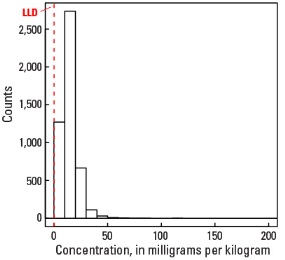
Histogram
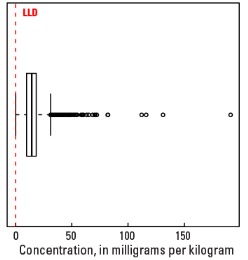
Boxplot
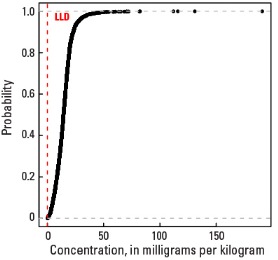
Empirical cumulative distribution function
Statistics - A Horizon
| Number of samples | 4,813 |
| LLD | 0.1 mg/kg |
| Number below LLD | 0 |
| Minimum | 0.2 mg/kg |
| 5 percentile | 3.7 mg/kg |
| 25 percentile | 10.0 mg/kg |
| 50 percentile | 14.6 mg/kg |
| 75 percentile | 18.7 mg/kg |
| 95 percentile | 27.5 mg/kg |
| Maximum | 254 mg/kg |
| MAD | 6.38 mg/kg |
| Robust CV | 43.7 % |
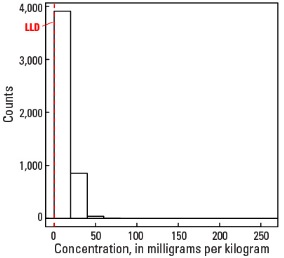
Histogram
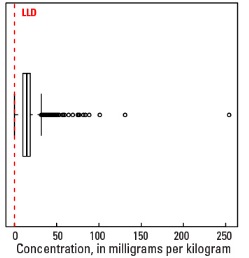
Boxplot

Empirical cumulative distribution function
Statistics - C Horizon
| Number of samples | 4,780 |
| LLD | 0.1 mg/kg |
| Number below LLD | 0 |
| Minimum | 0.2 mg/kg |
| 5 percentile | 4.5 mg/kg |
| 25 percentile | 10.7 mg/kg |
| 50 percentile | 15.6 mg/kg |
| 75 percentile | 20.3 mg/kg |
| 95 percentile | 30.2 mg/kg |
| Maximum | 288 mg/kg |
| MAD | 6.97 mg/kg |
| Robust CV | 44.7 % |
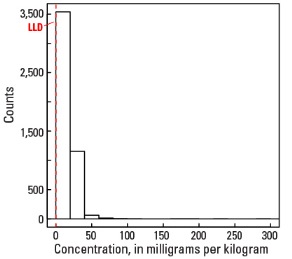
Histogram
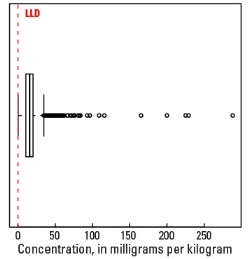
Boxplot
